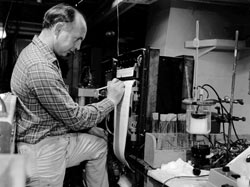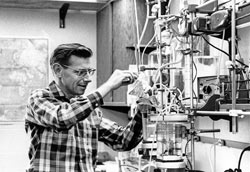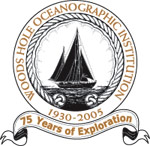This is an archived site. This site is no longer being maintained or reviewed for broken links.
Down to the Sea for Science – Science Feature
Considering Marine Bacteria: A Short History of WHOI Microbiology
 |
|
|
Henry Bigelow invited Selman Waksman to develop the Institution’s first program in marine microbiology in 1931. Here, in 1932, Waksman gets a bit of fresh air to relieve his seasickness during his only Atlantis cruise—after that he sent assistants to collect samples. (WHOI Archives Photo) |
|
 |
|
|
Stanley Watson monitors the oxygen uptake of microbes in a seawater sample during a 1961 Chain cruise. (WHOI Archives Photo) |
|
 |
|
|
Holger Jannasch works with a chemostat in his laboratory about 1966. The continuous culture apparatus was designed to allow Jannasch and colleagues to provide a continuous flow of nutrients to the marine sulfate-reducing bacteria they were studying. (WHOI Archives Photo) |
Henry Bigelow asked Selman Waksman in the spring of 1931 whether he thought the new oceanographic institution should “consider marine bacteria.” Waksman, a Rutgers University researcher, answered affirmatively and, after spending a month in Woods Hole the following summer, presented Bigelow with a plan for a program in marine bacteriology. Every summer from then until 1942, Waksman and several colleagues worked at WHOI. Waksman suffered terrible seasickness during a trip with Bigelow in 1932, so he was excused thereafter from Bigelow’s maxim that all investigators should go to sea each year, and assistants went out on Atlantis in his place.114 Many of the problems Waksman’s group addressed are still topical today, including the nature of bacterial populations in seawater and sediments, bacteria involved in the nitrogen cycle, transformations of dissolved organic matter, and the agents responsible for wasting disease in eelgrass.
Though Waksman later served on the WHOI Corporation, by 1942 his attention was largely focused on the search for antibiotics. He was awarded the Nobel Prize in Physiology/Medicine in 1952 for the discovery of streptomycin, the first antibiotic effective against tuberculosis.
There was little activity in microbiology for the rest of the 1940s. However, in 1951, Alfred Redfield offered Stanley Watson, then at the University of Washington’s Friday Harbor Laboratory, a one-year fellowship to renew the study of eelgrass wasting disease and its causative agent, Labyrinthula. Watson left in 1952 to pursue graduate studies at the universities of Washington and Wisconsin, but returned in 1957 to initiate investigations of marine nitrifying bacteria. Extensive studies over the next thirty years identified many novel nitrifiers and brought his laboratory recognition as a world authority on these unusual bacteria, which play a central role in marine and terrestrial nitrogen cycles. Watson also had a second career in biotechnology after determining that the clotting system in the blood of horseshoe crabs that he was using to measure bacterial biomass in seawater might have a medical application. His success in marketing a product to screen for bacterial toxins in pharmaceutical products allowed him to become a significant WHOI benefactor.
Watson met German microbiologist Holger Jannasch in 1959 and invited him to visit Woods Hole. Later, after completing advanced studies in Germany, Jannasch joined the WHOI scientific staff in 1963. Over the next thirty-five years, he and his WHOI colleagues made major contributions in three areas. First they studied the growth and ecology of bacteria at very low nutrient concentrations. Next they investigated the ecology of bacteria living under high pressure and at low temperatures (inspired by the remarkable preservation of lunches in the sunken Alvin). Their third area of study involved one of the twentieth century’s great discoveries in microbial ecology, that the abundant life surrounding the deep-sea hydrothermal vents is supported by bacterial chemosynthesis associated with sulfur oxidation.
This long history of bacterial research at WHOI continues today with investigations of various microbial processes in the ocean, including hydrothermal vent ecology, the role of cyanobacteria (photosynthesizing microbes) and other bacteria in the nutrient cycles of the ocean, and microbial dissolution and growth on deep-sea minerals.

